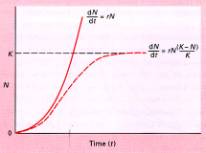The relation of Optimum to Optimality
and their importance in ecological perspectives
![]()
![]()
simple concepts
optimum is beneath a level (K) at which repair is no longer an option.
This |
graph has five components: | two axes, a constant, & two formulas. |
|---|---|---|
| Y axis |  |
overshoot |
| K | ---------- threshold |
|
| N | minimum
|
|
| Amount | ||
| Zero | Time | X axis |
Defining terms
N any number of increasing amount
K is the constant ------------
d is the change in some amount
t or T is over time
r is the rate of change of slope of the red lines called curves.
1) There is a solid red curve (steep)
2) There is a broken red curve that peaks at K .
The point of the contrasting curves on this graph is to visually display the difference between a curve leading to a threshold (2) and one that exceeds (1) the same level of performance, breaking the barrier, going above edge of the other curve's peak, or overcomes the threshold.
![]()
Optimum and optimality
Complex concepts
The difference between gross primary productivity and net primary productivity is by analogy the transfer of these assumptions to what a plant, or patch of vegetation must do in order to persist under conditions of varying radiation.
The larger the number of different plant species shown in red and amber to green colors on the maps contrasts with the pale to dark blue where fewer numbers of species make up the vegetative communities in those parts of the globe.
A. There are limits to the amount and the kinds of vegetation on earth.
B. The variety or diversity of plant species is a rough indicator of ecosystem needs.
Evidence
The argument
"You don't know what you got 'till its gone,
The paved paradise and put up a parking lot."
Joni Mitchell
The optimum level of exploitable wealth is somewhere below the maximum sustained yield because the rate at which we are polluting and the rates at which we consume resources is increasing along with entropy of the natural or cultural systems to perform at any maximum sustained yield level. Fishery, forestry or food-yield declines or soil loss are just some indicators that we are beyond the impact threshold due to population, consumption, and waste.
When combining the diversity patterns with population growth the availability for water to serve human and biological needs simultaneously without degrading human and ecological communities becomes a significant problem apparent on local, regional, and even a global scale.
"The supply of fresh water to people is already inadequate to meet human and ecosystem needs in large areas of the world. . . ." Ehrlich and Ehrlich, P. 205
Why don't we see that water is crucial to plant–hence the food supplies'--growth?
Norms, behavioral
"How do norms evolve? The question is at the very center of the quest to understand cultural evolution and resolve today's human predicament.... Norms provide a cultural stickiness or viscosity that can sustain adaptive behavior and retard detrimental changes in society ....Equally though, stickiness can inhibit the introduction and spread of beneficial behaviors. . . ."
p. 115.
What is the predicament? It is four-fold:
1. • Declining trends in the capacity of ecosystems to render pollutants harmless, keep nutrient levels in balance, give protection. . . ."
2. • The supply of fresh water to people is already inadequate to meet human and ecosystem needs in large areas of the world. . . ."
3. • Fish cannot continue to be harvested from wild populations at the present rate.
4. • The supply of certain ecosystem services has increased at the expense of others.
pp. 204-205.
Conclusion
There is an optimal level of extraction, beyond which we must adjust our rate of withdrawal, our frequency of extraction to allow for recovery, or increase the efficiency with using well what we have.
The persistent reinforcement of actions, in spite of their recurrent consequences, is a kind of mania.
"The paradox is that cultural stickiness, that 'carrying forward' by individuals and groups, seems to be highly beneficial, at least over certain periods, whereas at other times cultural continuity, can lead to disaster."
p. 168
"The population problem in the United States was more severe than that in many 'overpopulated' poor nations because of the high level of affluence and wasteful consumption in the US."
p. 205-206.
To sustain affluence among more and more people means we must see the cost of technology as an ongoing investment in a recurrent need to repair sophisticated, electrical, industrial, agricultural or municipal needs with ever more ecosystem services, if our resources are to: A) renew themselves and B) be ever capable of resisting damage, decay or demise that is inherent in any natural and cultural system due to entropy.
This concept that we must invest in ecosystems goods and services at levels commensurate with our demands or impacts is called preservation of biological wealth or natural capital.
Optimality is that state of affairs where the ongoing investment in the ecological basis of production of timber, fisheries or soil is 1) commensurate with our rising demands based on impacts, and 2) not sacrificed for private profit at the public's expense.
![]()
Terms | Argument | Evidence | Summary | So what | Where to?
![]()